Augmented reality significantly enhances user engagement in interactive storytelling by creating immersive experiences. This technology enables real-time interaction with characters and environments, enriching narratives across gaming, education, and marketing. It fosters emotional connections through personalized storytelling while also presenting challenges such as technical limitations and user experience concerns. Notable applications like Pokémon GO and Harry Potter: Wizards Unite illustrate the potential of AR to transform storytelling into dynamic, engaging experiences.
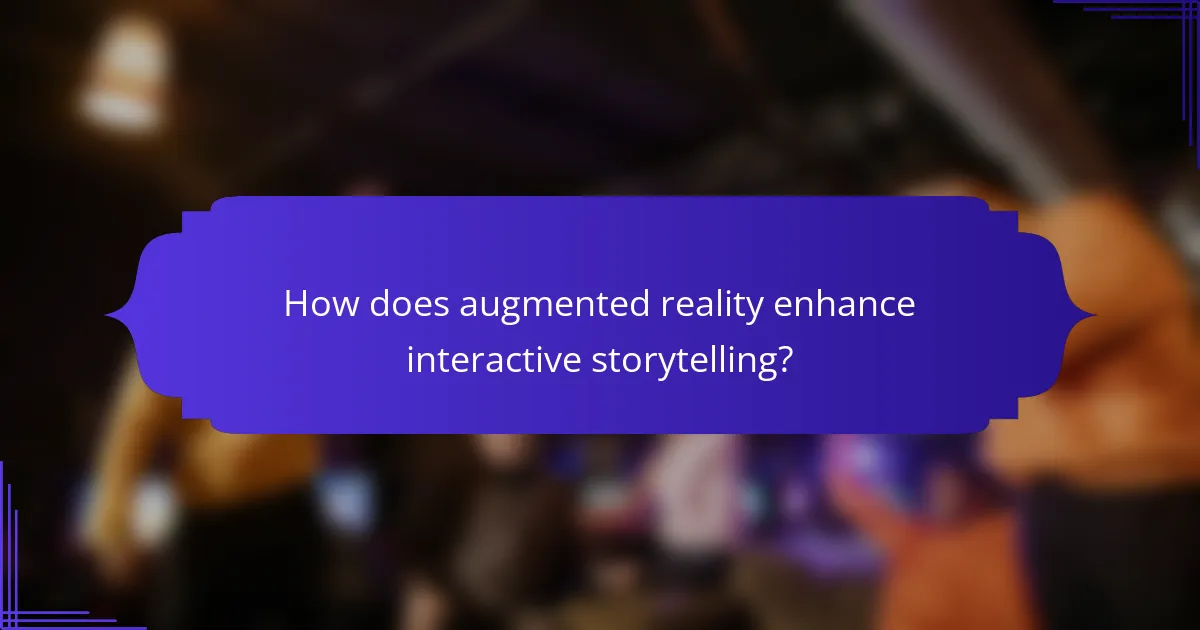
How does augmented reality enhance interactive storytelling?
Augmented reality enhances interactive storytelling by immersing users in dynamic narratives. It allows for real-time interaction with characters and environments, enriching user engagement. For example, AR can overlay digital elements onto the physical world, creating unique experiences. This technology fosters emotional connections through personalized storytelling, making narratives more relatable and impactful.
What are the key features of augmented reality in storytelling?
Augmented reality enhances storytelling by blending digital elements with the real world, creating immersive experiences. Key features include interactive visuals, real-time user engagement, and contextual information overlays. These attributes deepen narrative immersion and foster emotional connections. As a result, users become active participants in the story, enhancing retention and enjoyment.
Which technologies are driving augmented reality in interactive narratives?
Technologies driving augmented reality in interactive narratives include computer vision, depth tracking, and geolocation. These technologies enhance user engagement by creating immersive environments that respond to user interactions. Computer vision allows devices to recognize and interpret real-world objects, while depth tracking enables accurate placement of virtual elements in physical spaces. Geolocation provides context by integrating location-based experiences. Together, these technologies transform storytelling into a dynamic and interactive experience.
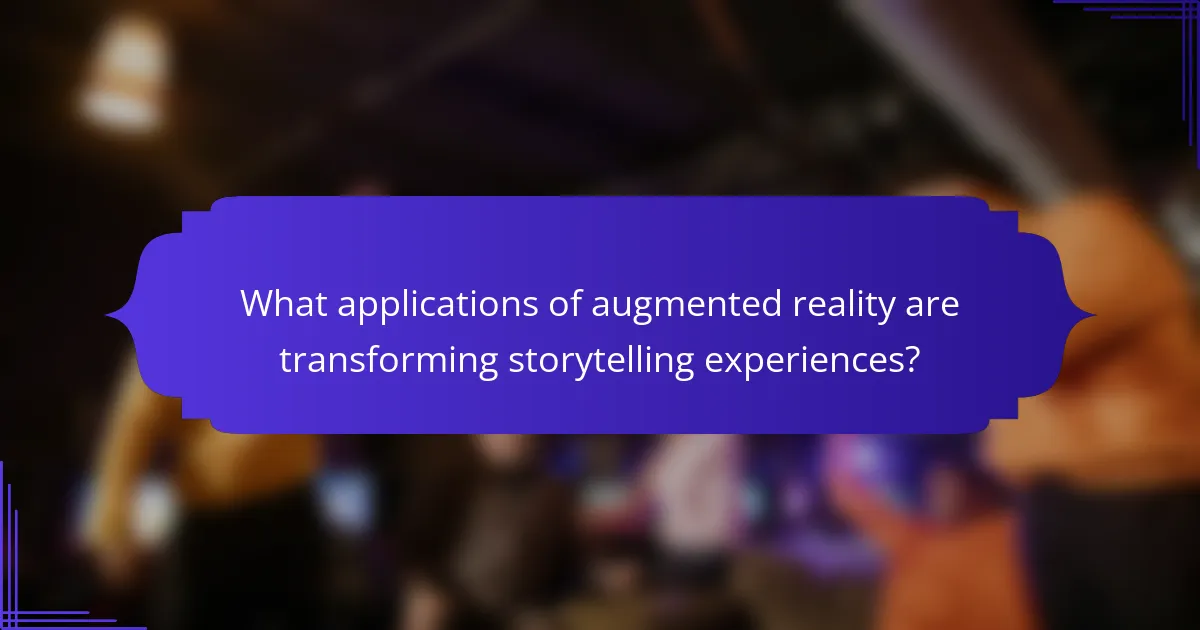
What applications of augmented reality are transforming storytelling experiences?
Augmented reality is transforming storytelling experiences by creating immersive, interactive environments. Applications include enhancing narratives in gaming, education, and marketing. For example, AR in gaming allows players to interact with characters in real-world settings, increasing engagement. In education, AR provides dynamic visual aids that deepen understanding. Marketing campaigns leverage AR to create memorable brand experiences, driving consumer interest. These applications enhance user engagement by blending digital content with physical environments, fostering a more profound connection to the story.
How are educational institutions utilizing augmented reality in storytelling?
Educational institutions are increasingly using augmented reality in storytelling to enhance engagement and interactivity. This technology allows students to experience narratives in immersive ways, making learning more effective and enjoyable.
For example, AR can bring historical events to life, enabling students to visualize and interact with the past in real-time. This method fosters deeper understanding and retention of information. Additionally, AR tools encourage collaboration among students, as they can share experiences and insights during storytelling activities.
The benefits of AR in education include increased motivation, improved spatial awareness, and the ability to cater to various learning styles. As a result, students become more active participants in their learning journey, leading to higher levels of engagement and satisfaction.
Overall, augmented reality transforms traditional storytelling into a dynamic and interactive experience, making it a valuable tool for educational institutions.
What role does augmented reality play in marketing and brand storytelling?
Augmented reality enhances marketing and brand storytelling by creating immersive experiences that engage users. This technology allows brands to interact with consumers in innovative ways, making narratives more compelling.
AR applications include virtual try-ons, interactive ads, and gamified experiences that increase user participation. Benefits encompass improved brand recall, higher engagement rates, and the ability to convey complex messages visually. User engagement is elevated as AR captures attention and encourages exploration, fostering a deeper emotional connection with the brand.
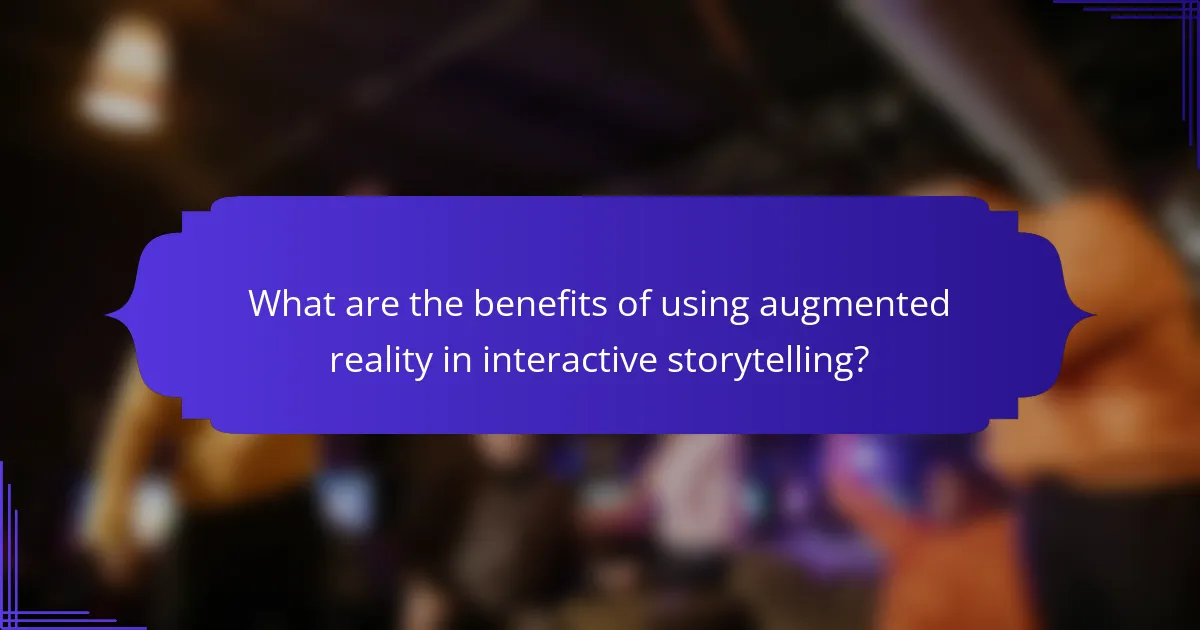
What are the benefits of using augmented reality in interactive storytelling?
Augmented reality enhances interactive storytelling by creating immersive experiences that engage users on a deeper level. It allows for real-time interaction with digital elements, making narratives more dynamic and personalized. Users can explore stories through their environment, increasing emotional connection and retention. Additionally, augmented reality can facilitate collaborative storytelling, enabling multiple users to participate simultaneously, fostering community engagement.
How does augmented reality improve user engagement and immersion?
Augmented reality enhances user engagement and immersion by creating interactive experiences. Users feel more connected to the narrative through visual and auditory elements that respond to their actions. This technology allows for real-time interaction, making storytelling more dynamic and personalized. As a result, users are more likely to retain information and develop emotional connections to the content.
What impact does augmented reality have on narrative retention and comprehension?
Augmented reality significantly enhances narrative retention and comprehension by immersing users in interactive environments. This technology allows users to visualize and engage with story elements, leading to deeper emotional connections and improved memory recall. Studies show that users exposed to augmented reality experiences retain information better than through traditional storytelling methods. The unique attribute of augmented reality lies in its ability to combine digital content with the real world, making narratives more engaging and memorable.

Which user demographics are most engaged with augmented reality storytelling?
Younger audiences, particularly those aged 18-34, show the highest engagement with augmented reality storytelling. This demographic values immersive experiences, making them more likely to interact with AR content. Additionally, tech-savvy individuals and frequent social media users are more engaged, as they seek novel ways to consume narratives. Engagement also spikes among gamers, who appreciate interactive elements in storytelling.
What preferences do millennials and Gen Z have regarding augmented reality narratives?
Millennials and Gen Z prefer immersive and interactive augmented reality narratives that enhance storytelling. They value personalization, interactivity, and social sharing features. These preferences drive engagement and create memorable experiences. For example, AR applications that allow users to influence story outcomes resonate well with these generations. Additionally, they enjoy narratives that incorporate gamification elements, making the experience more engaging and rewarding.
How do cultural factors influence user interaction with augmented reality stories?
Cultural factors significantly shape user interaction with augmented reality stories. These influences affect user engagement, narrative interpretation, and emotional resonance.
Cultural backgrounds dictate preferences for storytelling styles, visual aesthetics, and character development. For instance, users from collectivist cultures may prefer stories emphasizing community, while individualistic cultures may favor personal journeys.
Moreover, cultural symbols and references enhance relatability, improving immersion. Users familiar with specific cultural contexts may engage more deeply, resulting in a richer experience.
Finally, varying technological access and literacy across cultures can impact how users interact with augmented reality. Users in tech-savvy cultures may explore features more extensively than those in less developed regions.
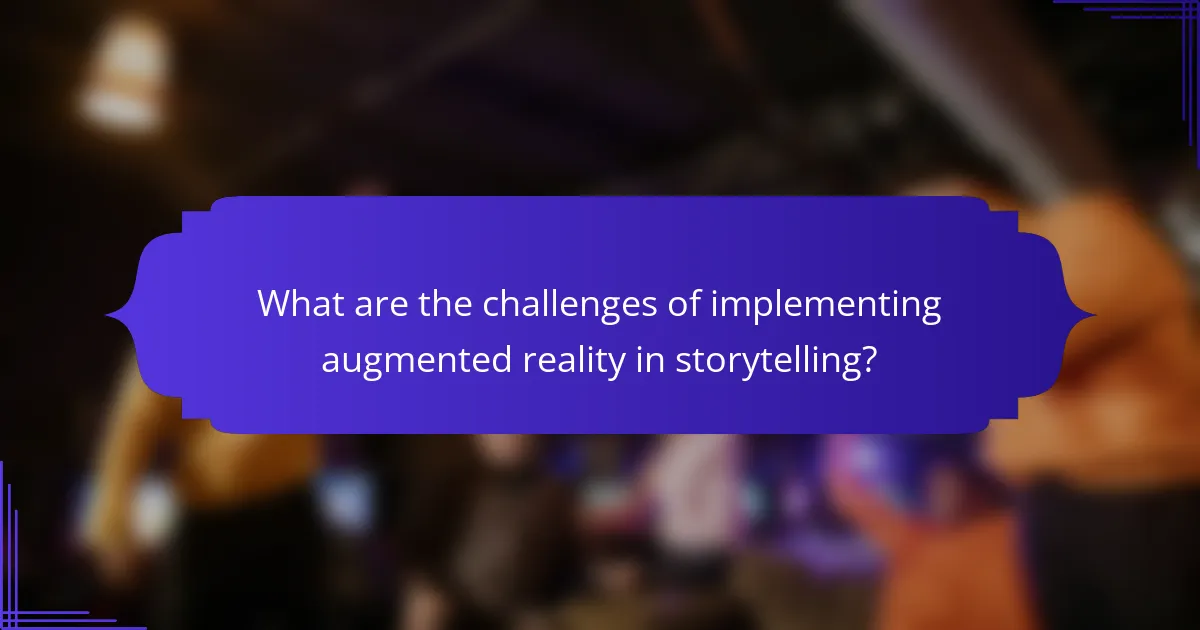
What are the challenges of implementing augmented reality in storytelling?
Implementing augmented reality in storytelling faces several challenges. Technical limitations, such as device compatibility and software integration, hinder widespread adoption. User experience concerns arise from potential distractions and the learning curve associated with new technology. Content creation requires significant resources to develop engaging AR experiences. Additionally, ensuring accessibility for diverse audiences poses a challenge. Finally, privacy and security issues related to data collection can deter users from fully engaging with AR storytelling.
What technical limitations do creators face with augmented reality?
Creators face several technical limitations with augmented reality, including hardware constraints, software compatibility issues, and user experience challenges. Hardware limitations often involve the need for high processing power and advanced sensors, which can restrict accessibility. Software compatibility can hinder the integration of AR applications across various devices and platforms. Additionally, ensuring a seamless user experience can be difficult due to varying levels of user familiarity with AR technology. These factors collectively impact the effectiveness of augmented reality in interactive storytelling.
How can creators overcome user accessibility issues in augmented reality experiences?
Creators can enhance user accessibility in augmented reality experiences by implementing inclusive design principles. They should prioritize user feedback to identify barriers and adapt content accordingly. Utilizing clear visual cues and auditory instructions improves navigation for diverse users. Additionally, offering customizable settings allows users to tailor experiences to their needs, promoting engagement. Integrating assistive technologies can further enhance accessibility, ensuring that all users can enjoy augmented reality storytelling.
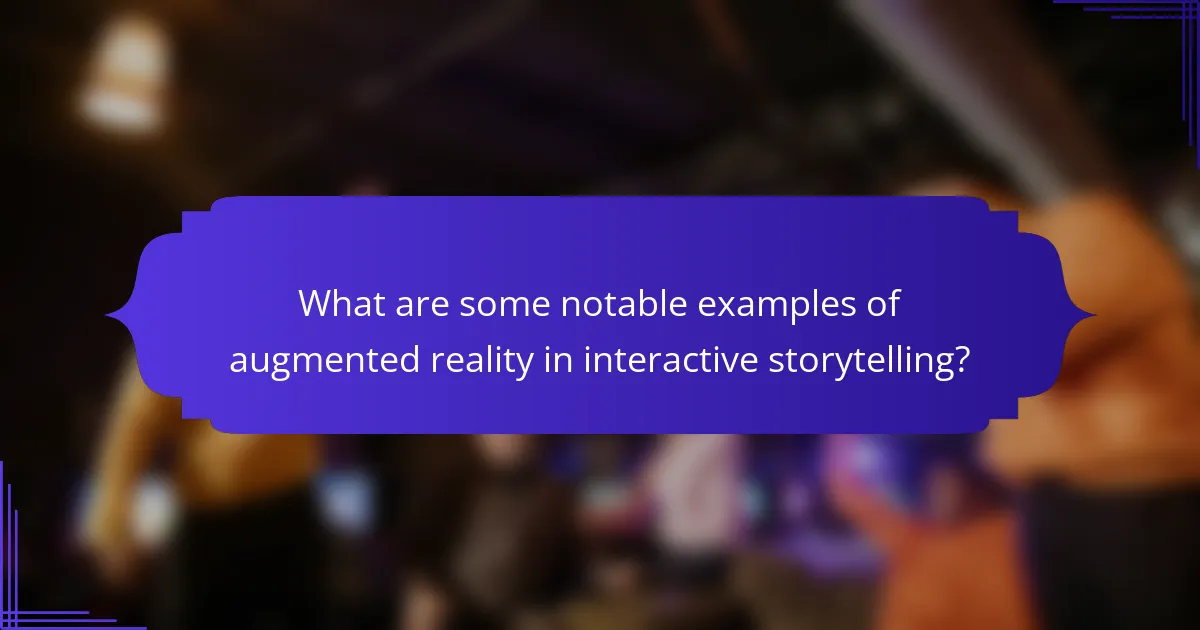
What are some notable examples of augmented reality in interactive storytelling?
Notable examples of augmented reality in interactive storytelling include Pokémon GO, which blends real-world exploration with narrative quests; the Harry Potter: Wizards Unite app, which integrates story elements into location-based gameplay; and the interactive experience of the New York Times’ “The Displaced,” which uses AR to enhance storytelling about refugees. These applications engage users by merging immersive experiences with meaningful narratives.
Which successful case studies highlight innovative uses of augmented reality in storytelling?
Successful case studies of augmented reality in storytelling include projects like “Pokémon GO,” which enhanced real-world exploration with digital elements, and “The Walking Dead: Our World,” which integrated AR gameplay into narrative experiences. Both cases demonstrate increased user engagement through interactive elements. Another example is “IKEA Place,” allowing users to visualize furniture in their homes, effectively merging storytelling with practical application. These innovations showcase how AR transforms storytelling by blending digital narratives with physical environments.
What lessons can be learned from failed augmented reality storytelling projects?
Failed augmented reality storytelling projects highlight key lessons for future endeavors. They emphasize the importance of user experience and engagement. Projects often falter due to unclear narratives or technical limitations. Ensuring seamless integration of AR elements with the story enhances immersion. Additionally, understanding the target audience’s preferences is crucial for success. Testing prototypes with real users can identify potential challenges early. Finally, maintaining a balance between innovation and accessibility can lead to more successful outcomes.
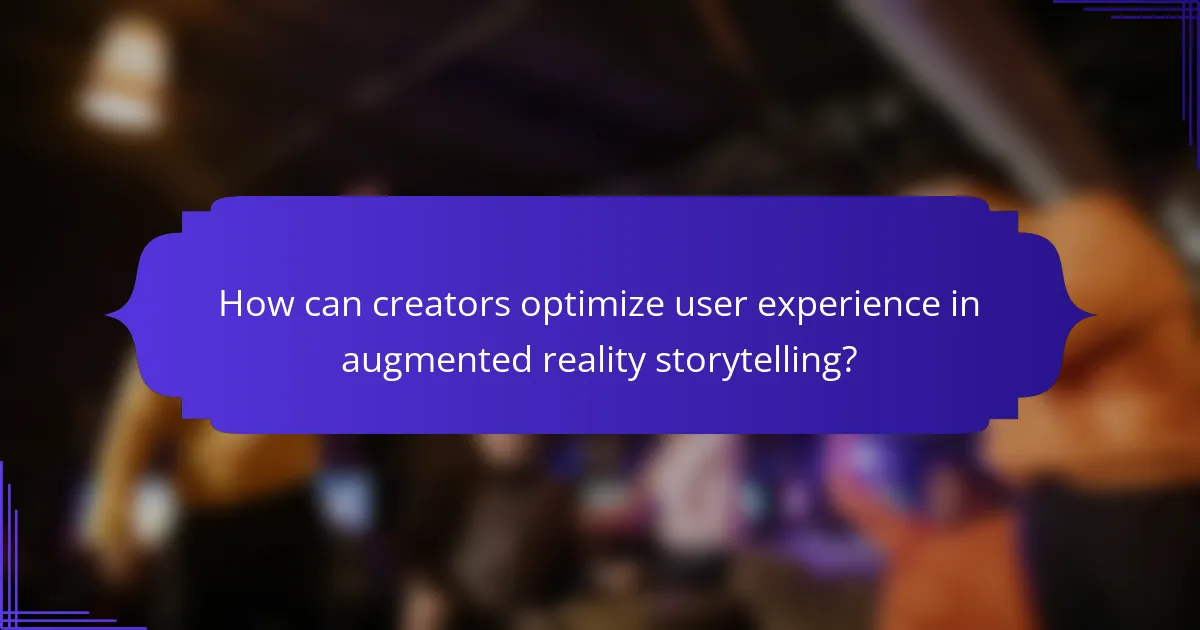
How can creators optimize user experience in augmented reality storytelling?
Creators can optimize user experience in augmented reality storytelling by enhancing interactivity and immersion. Key strategies include utilizing user-centric design, integrating real-time feedback, and employing narrative techniques that resonate with the audience.
User-centric design focuses on intuitive interfaces that facilitate seamless engagement. Real-time feedback allows users to influence the story, fostering a sense of agency. Narrative techniques, such as branching storylines, create personalized experiences that enhance emotional connections.
By prioritizing these aspects, creators can significantly improve user engagement and satisfaction in augmented reality storytelling.
What best practices should be followed when designing augmented reality narratives?
To design effective augmented reality narratives, prioritize user engagement, interactivity, and immersive experiences. Integrate storytelling elements that enhance emotional connections.
Utilize clear visual cues and intuitive interfaces to guide users seamlessly through narratives. Establish context through compelling character development and relatable scenarios.
Leverage feedback mechanisms to adapt narratives based on user choices, fostering personalized experiences. Incorporate multi-sensory elements to deepen immersion and maintain user interest.
Test narratives with target audiences to refine usability and engagement strategies, ensuring the final design resonates effectively.
What common mistakes should be avoided in augmented reality storytelling?
Common mistakes in augmented reality storytelling include neglecting user experience, overcomplicating narratives, and failing to integrate technology seamlessly. These pitfalls can diminish engagement and storytelling effectiveness. Prioritizing clarity, simplicity, and user interaction enhances the overall impact of augmented reality applications.
